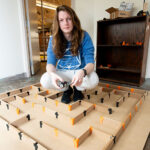
The Influence of Familiarity with Faces on the Other-Race Classification Advantage

Name: Stacey Park
Major: Psychology
Advisor: Dr. Grit Herzmann; Dr. John Neuhoff (second reader)
Own-race faces are often recognized faster than other-race faces, but the opposite trend occurs when classifying faces by race, in which the latter is known as the other-race classification advantage. Additionally, known faces are recognized more easily than unknown faces. By combining two different datasets that utilize the same race classification task, we tested the influence of familiarity with faces on the other-race classification advantage to understand how face race classification tendencies would differ between known and unknown faces. Both black and white participants were in Experiment 1, while Experiment 2 exclusively had white participants. In both, behavioral data was measured for reaction time and accuracy when performing the race classification task, and Experiment 2 also included the measurement of three neural correlates of face processing: N170, N250, and P300. While the current study did not find behavioral evidence of the influence of racial familiarity on the other-race classification advantage, there was evidence of faster reaction time and higher accuracy for white participants when viewing other-race faces compared to own-race faces and an overall faster reaction time and higher accuracy for known faces compared to unknown faces. Only the N170 displayed a significant race by familiarity interaction, alluding to its sensitivity to unknown other-race faces compared to unknown own-race faces. In conclusion, while there was no evidence of the influence of familiarity with faces on the other-race classification advantage, there is evidence of faster classification for known faces, and the other-race classification advantage for white participants and the N170 component.
Posted in Comments Enabled, Independent Study, Symposium 2022 on April 26, 2022.
6 responses to “The Influence of Familiarity with Faces on the Other-Race Classification Advantage”
Related Posts
Related Areas of Study
Psychology
Do research, work with faculty mentors, and tailor a psychology program to your interests
Major Minor


It is really fun to see your senior research, Stacey! Thanks for sharing this work. Wishing you all the best in your next steps!
Stacey – Thanks for sharing this research. The reaction time findings are interesting to think about in the context of of other measures that utilize reaction time (such as implicit bias).
Hi Stacey! This is really interesting! Congratulations, and thank you for sharing your work! Best wishes for what’s ahead! 😀
Omg hi Stacey. Great job on your is in so glad you are able to share this to everyone! You worked so hard on this and I’m impressed with the final result.
Stacey, congratulations on this impressive achievement! Wishing you the best for the next steps ahead of you.
This is so interesting! To think that we were just in face recognition together a few years ago! I’m so proud of you for completing such an amazing IS!